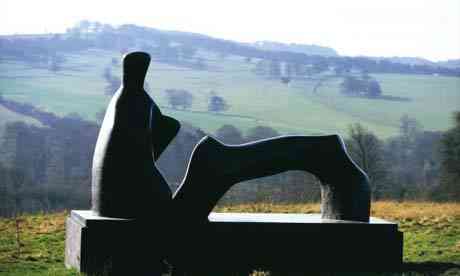
While he is majority appropriate well well well well well known for his sculptures of recumbent women, Henry Moore additionally constructed "darker and some-more formidable work" as a Tate Britain muster will show
Henry Moore, Britain"s majority appropriate well well well well well known and majority vicious sculptor, is mostly seen as a buttoned-up Yorkshireman whose work is as tractable and protected as it gets. But a new muster opening tomorrow reveals his demons: this is a man majority darker, edgier and some-more formidable than we realise, contend curators.
Tate Britain tomorrow opens the majority vicious muster of Moore functions for a generation. It hopes to warn those who think they know Moore – and he is mostly well well well well well known for his outrageous postwar outside sculptures – as well as introducing him to a total new audience.
More than 150 works, together with mill sculptures, timber carvings, bronzes and drawings, have been collected for what is additionally one of Tate Britain"s longest exhibitions in new mental recall – it will run for roughly 6 months. A mouthpiece pronounced it was "an experiment" and the goal was the show would capture some-more abroad visitors during the summer.
Chris Stephens, the show"s co-curator, called it reassessment, or "a revisiting". He pronounced the muster was environment out to show there is majority some-more to the artist than his simply recognizable kindly dull womanlike total and epitome forms. Familiarity with the artist had roughly bred contempt, he said. "We think we know Henry Moore given he is still so perceivable and recognizable and additionally still so popular."
Instead Moore was producing art that was sensitive by the mishap and horrors of the initial universe war. And when it came to sex, he was sculpting pieces that were unconditionally intimately driven and erotically charged. "The sort of things we accept but subject about Francis Bacon or Picasso but they additionally run by Henry Moore"s work as well."
Stephens believes Moore"s initial universe fight practice – 3 buliding of his corps died and was gassed at the conflict of Cambrai – had a surpassing outcome on his art. It brought a dark and mental complexity to his work.
Moore, son of a Yorkshire spark mining engineer, was regularly demure to speak privately about what sensitive his art, he was from a category and era who only did not go on about their emotions or their feelings.
After the fight Moore became a luminary artist, formulating outrageous functions in places similar to Harlow and Stevenage that were emblematic of the new gratification state, of the reformation of Britain.
24 years after his death, he stays renouned but not as regarded as a little hold he should be. "The maze is that he is still incredibly popular, incredibly familiar," pronounced Stephens, "and nonetheless he someway lacks a vicious respect. We longed for to relapse to what was it about Moore that finished him the majority vicious sculptor of the complicated age."
Moore competence be one of Britain"s biggest artists nonetheless the last big show clinging to his work was a commemorative show at the Royal Academy in 1988, dual years after his death.
For exhibitions at the Tate – an establishment Moore is firm up with and to that he donated a large volume of work – you have to go behind to a drawings retrospective in 1977, his 70th birthday retrospective in 1968 and prior to that the 1951 Festival of Britain retrospective.
"It is a era given his last vital show yes and mostly it takes a generation," pronounced Stephens. "You need a relapse in time sometimes, it allows you to move new ideas and ways of seeking at art."
Richard Calvocoressi, executive of the Henry Moore Foundation, said: "It is no deceit to contend that this is the majority vicious Henry Moore muster in the 33-year hold up of the foundation. It is loyal that we"ve finished exhibitions in the last 3 decades all over the world, in China, Brazil, the United States but this is undoubtedly the majority vicious show in the last thirty years. It is not a retrospective and it"s all the some-more sparkling and smart for that."
The muster additionally asserts that Moore, as Official War Artist during the second universe war, constructed drawings – well well well well well known as the Shelter Drawings – that he claimed were finished from his own tact when, in fact, they were copied from photographs in Picture Post.
While this creates it appear that Moore was a dissembler, according to Stephens the revelations raise Moore"s repute even more. He competence not have longed for it well well well well well known but by reproducing the photographs he was utilizing automatic facsimile techniques that artists such as Bacon and Richard Hamilton used.
• Henry Moore, Tate Britain twenty-four Feb – 8 August
No comments:
Post a Comment